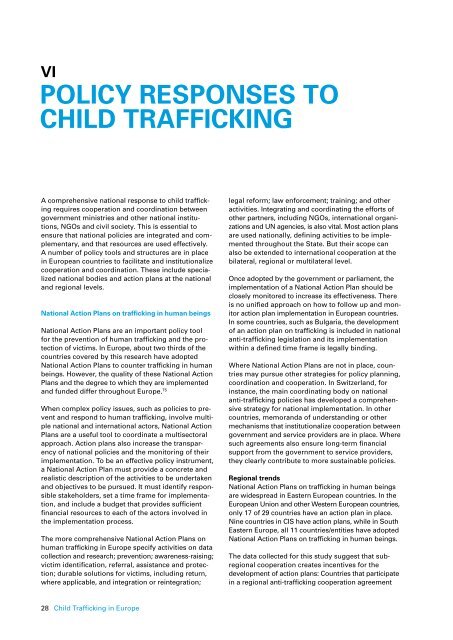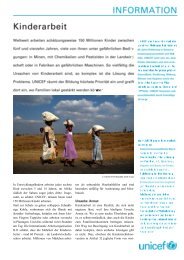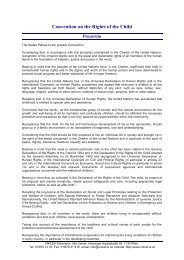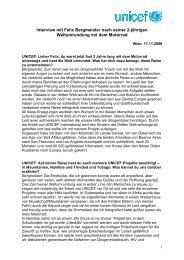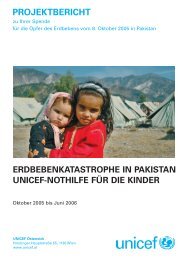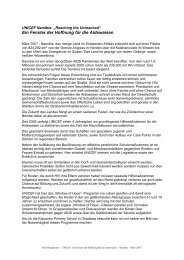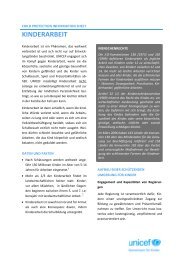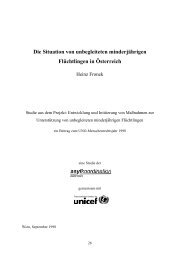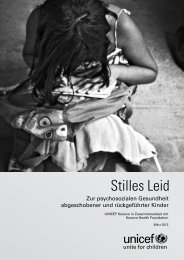Child Trafficking in Europe
Child Trafficking in Europe
Child Trafficking in Europe
You also want an ePaper? Increase the reach of your titles
YUMPU automatically turns print PDFs into web optimized ePapers that Google loves.
Vi<br />
poliCY rEsponsEs To<br />
<strong>Child</strong> TraffiCk<strong>in</strong>g<br />
A comprehensive national response to child traffick<strong>in</strong>g<br />
requires cooperation and coord<strong>in</strong>ation between<br />
government m<strong>in</strong>istries and other national <strong>in</strong>stitutions,<br />
NGOs and civil society. This is essential to<br />
ensure that national policies are <strong>in</strong>tegrated and complementary,<br />
and that resources are used effectively.<br />
A number of policy tools and structures are <strong>in</strong> place<br />
<strong>in</strong> <strong>Europe</strong>an countries to facilitate and <strong>in</strong>stitutionalize<br />
cooperation and coord<strong>in</strong>ation. These <strong>in</strong>clude specialized<br />
national bodies and action plans at the national<br />
and regional levels.<br />
national action plans on traffick<strong>in</strong>g <strong>in</strong> human be<strong>in</strong>gs<br />
National Action Plans are an important policy tool<br />
for the prevention of human traffick<strong>in</strong>g and the protection<br />
of victims. In <strong>Europe</strong>, about two thirds of the<br />
countries covered by this research have adopted<br />
National Action Plans to counter traffick<strong>in</strong>g <strong>in</strong> human<br />
be<strong>in</strong>gs. However, the quality of these National Action<br />
Plans and the degree to which they are implemented<br />
and funded differ throughout <strong>Europe</strong>. 75<br />
When complex policy issues, such as policies to prevent<br />
and respond to human traffick<strong>in</strong>g, <strong>in</strong>volve multiple<br />
national and <strong>in</strong>ternational actors, National Action<br />
Plans are a useful tool to coord<strong>in</strong>ate a multisectoral<br />
approach. Action plans also <strong>in</strong>crease the transparency<br />
of national policies and the monitor<strong>in</strong>g of their<br />
implementation. To be an effective policy <strong>in</strong>strument,<br />
a National Action Plan must provide a concrete and<br />
realistic description of the activities to be undertaken<br />
and objectives to be pursued. It must identify responsible<br />
stakeholders, set a time frame for implementation,<br />
and <strong>in</strong>clude a budget that provides sufficient<br />
f<strong>in</strong>ancial resources to each of the actors <strong>in</strong>volved <strong>in</strong><br />
the implementation process.<br />
The more comprehensive National Action Plans on<br />
human traffick<strong>in</strong>g <strong>in</strong> <strong>Europe</strong> specify activities on data<br />
collection and research; prevention; awareness-rais<strong>in</strong>g;<br />
victim identification, referral, assistance and protection;<br />
durable solutions for victims, <strong>in</strong>clud<strong>in</strong>g return,<br />
where applicable, and <strong>in</strong>tegration or re<strong>in</strong>tegration;<br />
28 <strong>Child</strong> <strong>Traffick<strong>in</strong>g</strong> <strong>in</strong> <strong>Europe</strong><br />
legal reform; law enforcement; tra<strong>in</strong><strong>in</strong>g; and other<br />
activities. Integrat<strong>in</strong>g and coord<strong>in</strong>at<strong>in</strong>g the efforts of<br />
other partners, <strong>in</strong>clud<strong>in</strong>g NGOs, <strong>in</strong>ternational organizations<br />
and UN agencies, is also vital. Most action plans<br />
are used nationally, def<strong>in</strong><strong>in</strong>g activities to be implemented<br />
throughout the State. But their scope can<br />
also be extended to <strong>in</strong>ternational cooperation at the<br />
bilateral, regional or multilateral level.<br />
Once adopted by the government or parliament, the<br />
implementation of a National Action Plan should be<br />
closely monitored to <strong>in</strong>crease its effectiveness. There<br />
is no unified approach on how to follow up and monitor<br />
action plan implementation <strong>in</strong> <strong>Europe</strong>an countries.<br />
In some countries, such as Bulgaria, the development<br />
of an action plan on traffick<strong>in</strong>g is <strong>in</strong>cluded <strong>in</strong> national<br />
anti-traffick<strong>in</strong>g legislation and its implementation<br />
with<strong>in</strong> a def<strong>in</strong>ed time frame is legally b<strong>in</strong>d<strong>in</strong>g.<br />
Where National Action Plans are not <strong>in</strong> place, countries<br />
may pursue other strategies for policy plann<strong>in</strong>g,<br />
coord<strong>in</strong>ation and cooperation. In Switzerland, for<br />
<strong>in</strong>stance, the ma<strong>in</strong> coord<strong>in</strong>at<strong>in</strong>g body on national<br />
anti-traffick<strong>in</strong>g policies has developed a comprehensive<br />
strategy for national implementation. In other<br />
countries, memoranda of understand<strong>in</strong>g or other<br />
mechanisms that <strong>in</strong>stitutionalize cooperation between<br />
government and service providers are <strong>in</strong> place. Where<br />
such agreements also ensure long-term f<strong>in</strong>ancial<br />
support from the government to service providers,<br />
they clearly contribute to more susta<strong>in</strong>able policies.<br />
regional trends<br />
National Action Plans on traffick<strong>in</strong>g <strong>in</strong> human be<strong>in</strong>gs<br />
are widespread <strong>in</strong> Eastern <strong>Europe</strong>an countries. In the<br />
<strong>Europe</strong>an Union and other Western <strong>Europe</strong>an countries,<br />
only 17 of 29 countries have an action plan <strong>in</strong> place.<br />
N<strong>in</strong>e countries <strong>in</strong> CIS have action plans, while <strong>in</strong> South<br />
Eastern <strong>Europe</strong>, all 11 countries/entities have adopted<br />
National Action Plans on traffick<strong>in</strong>g <strong>in</strong> human be<strong>in</strong>gs.<br />
The data collected for this study suggest that subregional<br />
cooperation creates <strong>in</strong>centives for the<br />
development of action plans: Countries that participate<br />
<strong>in</strong> a regional anti-traffick<strong>in</strong>g cooperation agreement


